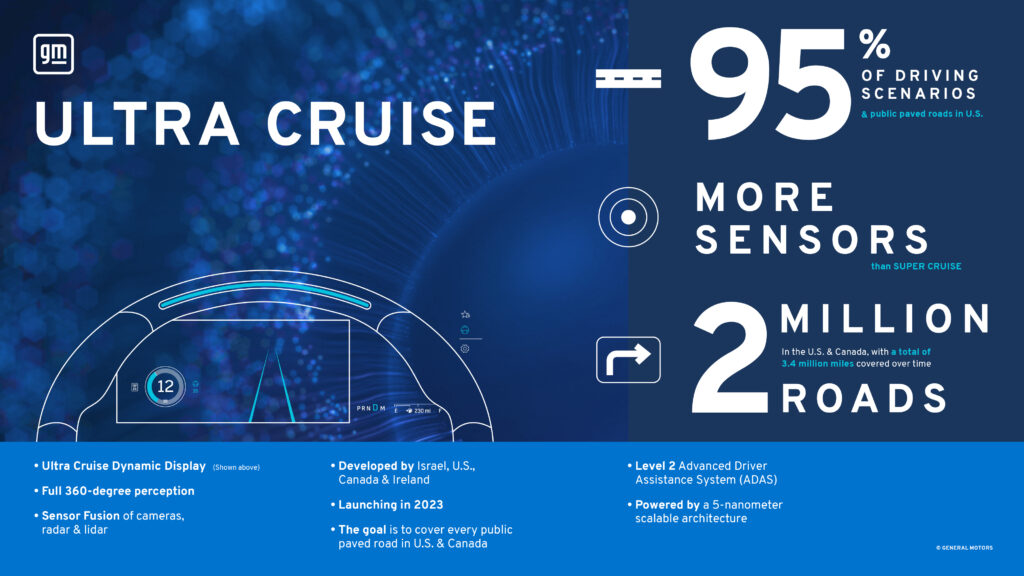GM will be the first company to use Qualcomm’s Snapdragon Ride Platform for advanced driver assistance (ADAS) technology, which features an industry-leading 5nm Snapdragon SA8540P SoC and SA9000P artificial intelligence accelerator. The US auto maker used CES 2022 in Las Vegas to announce that its next-generation hands-free ADAS system, Ultra Cruise, which will ultimately enable door-to-door hands-free driving in 95% of all driving scenarios in the USA and Canada, will be powered by Qualcomm’s Snapdragon Ride technology.
Ultra Cruise’s compute, which is about the size of two laptops stacked together, will be available in 2023 on vehicles including the ultra-luxury, fully electric Cadillac CELESTIQ. With high-performance sensor interfaces and memory bandwidth, it will, in combination with GM’s homegrown Ultra Cruise software stack, be capable of delivering robust door-to-door hands-free driving in 95% of all driving scenarios.
Ultra Cruise will cover more than 2,000,000 miles of roads at launch in the USA and Canada, with the capacity to grow up to more than 3,400,000 million miles. GM says customers will be able to travel truly hands-free with Ultra Cruise across nearly every road including city streets, subdivision streets and paved rural roads, in addition to highways.
“Despite its relatively small size, Ultra Cruise’s compute will have the processing capability of several hundred personal computers,” said Ken Morris, GM vice president of electric, autonomous and fuel cell vehicle programs. “It will take qualities that have distinguished GM’s advanced driver assist systems since 2017 to the next level with door-to-door hands-free driving.”
The Ultra Cruise compute will help power GM-developed ADAS software and features, including perception, planning, localization and mapping. These Ultra Cruise capabilities were developed in-house at GM engineering facilities in Israel, the USA, Ireland and Canada.
To ensure a robust and predictable system with minimal latency, GM integrated Ultra Cruise’s software on an optimal hardware design, overlaying cameras, radar and lidar. The company says this low-level, sensor fusion, which provides excellent detection and classification of data, and Ultra Cruise’s software stack are proprietary to GM, and will not be available on the automotive aftermarket.
The Ultra Cruise compute comprises two Snapdragon SA8540P SoCs and one SA9000P AI accelerator to deliver key low-latency control functions on 16-core CPUs and high-performance AI compute of more than 300 TOPS for camera, radar and lidar processing.
The Snapdragon SoCs are designed with 5nm process technology, enabling superior performance and power efficiency. The Snapdragon SA8540P SoCs will provide the necessary bandwidth for Ultra Cruise’s sensing, perception, planning, localization, mapping and driver monitoring.
“We are very proud of our collaboration with General Motors on one of the industry’s first uses of our Snapdragon SoCs in an automated driving system,” said Nakul Duggal, Qualcomm Technologies, Inc’s senior vice president and GM, automotive. “Ultra Cruise powered by Snapdragon Ride on Cadillac vehicles will be an experiential and technological leap forward for the industry.”
Along with Snapdragon Ride SoCs, which are designed to meet automotive system safety standards with multiple redundancies built in, the compute includes an Infineon Aurix TC397 processor for system safety integrity. The Aurix TC397 is categorized ASIL-D – the highest Automotive Safety Integrity Level.
GM says it minimized complexity within the compute, opting for an air-cooled instead of liquid-cooled system that avoids heavy and inefficient thermal cooling lines throughout the vehicle, made possible by Snapdragon Ride’s high-performance, high-efficiency design.
Ultra Cruise’s compute will also have the capability to evolve over time by leveraging Snapdragon Ride’s SoCs performance and high-speed interfaces for future expansion, as well as over-the-air software updates enabled through the Ultifi software platform and GM’s Vehicle Intelligence Platform electrical architecture.
Ultra Cruise at a glance
Ultra Cruise builds on the capabilities of GM’s existing Super Cruise ADAS feature, with new automated driving features intended to:
- Provide users with information based on their experience with the system through an all-new dynamic display.
- React to permanent traffic control devices.
- Follow internal navigation routes.
- Maintain headway; follow speed limits.
- Support automatic and on-demand lane change.
- Support left and right-hand turns.
- Support close object avoidance.
- Support parking in residential driveways.
Smart diagnostic and learning systems automatically identify scenarios where Ultra Cruise needs upgrading, triggering data recordings in vehicles equipped with the service. These recordings will then be processed through GM’s back office data ecosystem for continuous improvement of the system.
Ultra Cruise will join GM’s line-up of hands-free advanced driver-assist systems on select models in 2023, with Cadillac being the first to introduce the technology.


